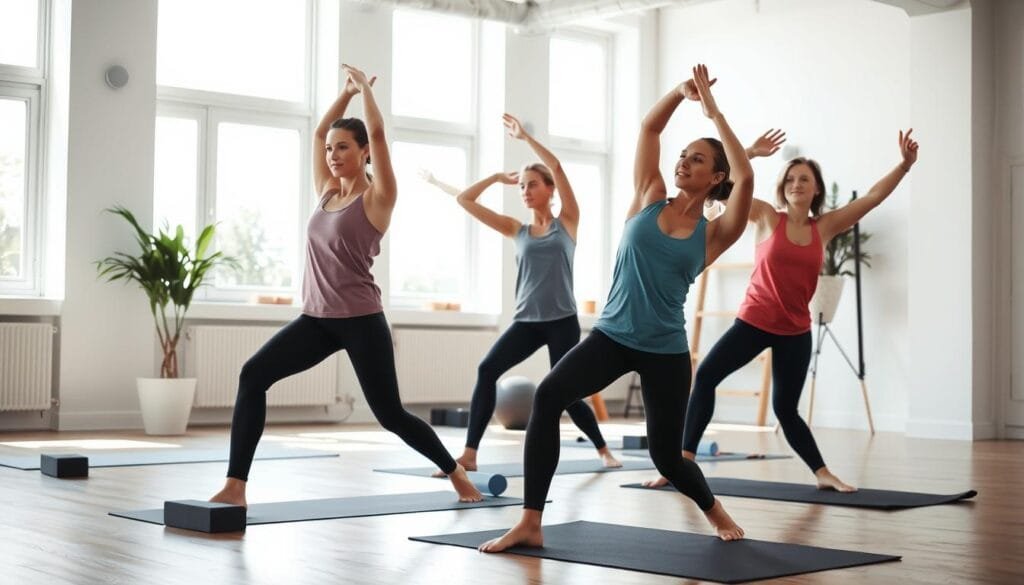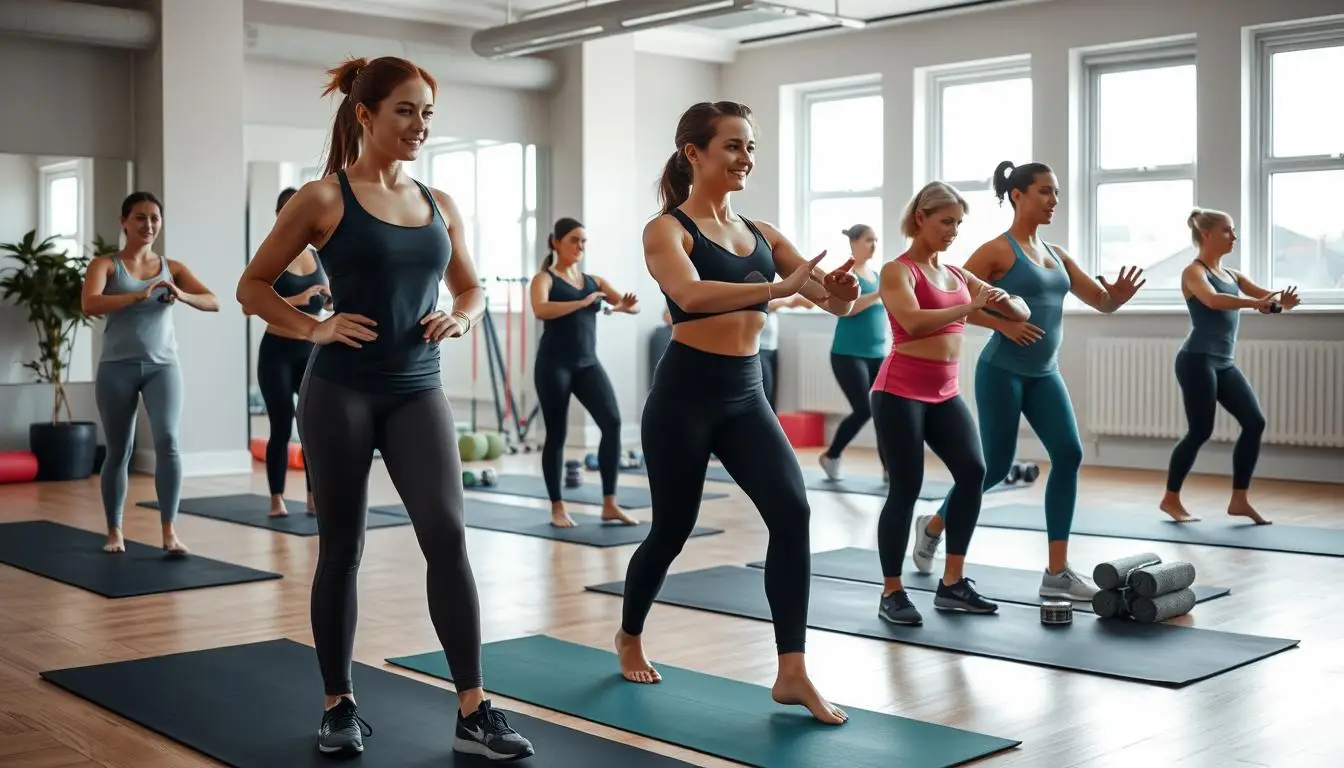Did you know 67% of adults aged 45-64 get a fitness-related injury each year? As we hit midlife, our bodies are more likely to get hurt during exercise. It’s key to prevent and recover from injuries to stay active. In this guide, we’ll cover the best ways to avoid and heal from common midlife fitness injuries. You’ll learn about preventing injuries, the importance of proper form, and how to warm up right. We’ll also share recovery techniques to keep you healthy and active for years.
Key Takeaways
- Understand common midlife fitness injuries and age-related factors
- Prioritize proper form and technique during exercise
- Incorporate effective warm-up routines to prevent injuries
- Listen to your body and avoid overtraining
- Utilize strength training, flexibility, and mobility work for injury prevention
- Optimize nutrition and hydration for injury prevention and recovery
- Implement recovery techniques like foam rolling, ice/heat therapy, and compression garments
By following these tips, you can keep a healthy, active lifestyle for years. Let’s explore each tip in more detail!
Understanding Common Midlife Fitness Injuries
Starting your midlife fitness journey is exciting. But, knowing about common injuries is key. This knowledge helps you avoid them and stay active and healthy.
Overuse Injuries
Overuse injuries happen when you stress a part of your body too much. This can be due to bad form or too much exercise. Tendinitis, stress fractures, and bursitis are examples.
To avoid these, start slowly with your workouts. Use the right form and rest enough between sessions.
Acute Injuries
Acute injuries come on suddenly, often from a fall or direct hit. Sprains, strains, and dislocations are common. To lower your risk, warm up well before you exercise.
Wear the right gear and don’t overdo it. This helps prevent these injuries.
Age-Related Factors
As we get older, our bodies change. This can make injuries more likely. Less bone density, muscle loss, and less flexibility are big factors.
Do exercises that help your bones, like weight-bearing activities. Also, add strength training and stretching to your routine.
Knowing about midlife fitness injuries helps you stay safe and effective. Always listen to your body and progress slowly. If you’re worried or in pain, get help from a professional.
The Importance of Proper Form and Technique
When we get older, proper form and exercise technique become more important for injury prevention. Our bodies are more likely to get hurt as we age. So, it’s key to focus on doing exercises right to avoid injuries and get the most benefits.
Correct form means paying attention to how your body is aligned and moving. It’s important for all kinds of exercises, like lifting weights, doing yoga, or cardio. Getting help from a fitness expert or taking classes that focus on form can help you stay safe and effective.
When lifting weights, it’s important to use the right amount of weight. Start with lighter weights and learn the technique first. It’s not about lifting the heaviest, but doing the exercise right. Trying to lift too much too soon can cause injuries and slow down your progress.
Doing different exercises helps prevent injuries too. Mix up your workouts and give your body time to rest. This helps avoid overworking any one area. A good fitness plan should include strength training, cardio, and stretching, as suggested for mid-age women to stay healthy.
Remember, proper form and technique are not just about avoiding injuries. They also help you work the right muscles and get the best results from your workouts. By focusing on doing exercises correctly, you can have a safe and rewarding fitness journey in midlife.
Effective Warm-Up Routines for Injury Prevention
Adding a good warm-up to your fitness plan is key to avoiding injuries and doing better. A warm-up gets your body ready for exercise by slowly increasing your heart rate and improving flexibility. It also turns on important muscles. Here are the main parts of a good warm-up routine:

Dynamic Stretching
Dynamic stretching is different from static stretching. It involves moving in a way that’s similar to your workout. This type of stretching boosts flexibility and gets your body warm. Examples include:
- Leg swings
- Arm circles
- Walking lunges
- Trunk rotations
Light Cardiovascular Activity
Doing some light cardio is a must in any warm-up. It increases blood flow, raises your heart rate, and gets you ready for harder exercise. Some light cardio activities are:
| Activity | Duration | Intensity |
|---|---|---|
| Brisk walking | 5-10 minutes | Low to moderate |
| Jogging | 3-5 minutes | Moderate |
| Cycling | 5-10 minutes | Low to moderate |
Activation Exercises
Activation exercises focus on the muscles you’ll use in your workout. They help with muscle coordination and get your body ready. Examples include:
- Glute bridges
- Plank variations
- Band pull-aparts
- Mini-band lateral walks
By adding these to your warm-up, you’ll be more ready for your workouts and less likely to get hurt. Make sure to spend about 10-15 minutes on your warm-up. Choose exercises that target the muscles you’ll use in your workout.
Listening to Your Body and Avoiding Overtraining
As a midlife fitness enthusiast, it’s key to listen to your body and avoid overtraining. Overdoing it can cause injuries, burnout, and slow down your fitness progress. Recognizing overtraining signs and taking rest days helps keep you healthy and injury-free.

Signs of Overtraining
Overtraining shows up in many ways, affecting both body and mind. Common signs include:
- Persistent fatigue and exhaustion
- Decreased performance and strength
- Increased muscle soreness and joint pain
- Elevated resting heart rate
- Difficulty sleeping or insomnia
- Mood changes, such as irritability or depression
- Frequent illnesses due to a weakened immune system
If you often feel these symptoms, it’s time to slow down and rethink your workout plan. Ignoring these signs can cause serious injuries and long recovery times.
Rest and Recovery Days
Rest and recovery days are as vital as your workouts. These days let your body fix muscles, refill energy, and adjust to exercise. Here are some tips for effective rest and recovery:
| Recovery Strategy | Benefits |
|---|---|
| Active recovery | Do low-intensity activities like walking, swimming, or yoga to help blood flow and ease muscle soreness. |
| Sleep | Try for 7-9 hours of sleep each night to help muscles heal, balance hormones, and keep your mind sharp. |
| Nutrition | Eat a balanced diet with enough protein, carbs, and healthy fats to aid muscle repair and energy boost. |
| Hydration | Drink lots of water all day to keep your body hydrated and working well. |
By listening to your body and focusing on rest and recovery, you can dodge the dangers of overtraining. This way, you can enjoy a safe and lasting fitness journey in your midlife years.
Prevention and Recovery: Tips to Avoid Injuries in Midlife Fitness
Starting your midlife fitness journey? It’s key to focus on injury prevention tips and exercise recovery techniques. This helps keep your workouts fun and safe. A few simple steps can lower injury risks and speed up recovery.
Try cross-training to prevent injuries. It means doing different exercises to work out different muscles and energy systems. This spreads out the stress and boosts your fitness and health.

Don’t rush into tough workouts. Starting too hard can hurt your muscles, joints, and tissues. Begin slowly and build up your strength and endurance. This lets your body get stronger and more resilient.
Good equipment is also vital for avoiding injuries. Shoes with good support and clothes that keep you dry are essential. They help reduce joint stress and prevent discomfort during exercise.
If you’re in pain during or after working out, get help. A fitness trainer or doctor can check your form and suggest ways to avoid injuries. Always listen to your body and get help when needed. This keeps your fitness journey healthy and enjoyable.
Strength Training for Joint Stability and Injury Prevention
As you get older, strength training becomes key for keeping your joints stable and preventing injuries. By doing the right exercises and using the right techniques, you can get stronger safely. This lets you stay active and enjoy your favorite activities without pain or limits.

Compound Movements
Compound movements work many muscles at once. They are great for people in midlife because they build strength and stability. This reduces injury risk. Some examples include:
- Squats
- Deadlifts
- Bench press
- Pull-ups
- Overhead press
Adding compound movements to your workout routine helps build a strong base. This makes daily activities and fun activities easier and more confident.
Progressive Overload
Progressive overload means slowly increasing the challenge for your muscles over time. You can do this by:
- Increasing the weight lifted
- Doing more repetitions
- Shortening rest times between sets
By always pushing your muscles a bit harder, you keep getting stronger and more stable, even as you age. But remember to listen to your body and not push too hard too fast, to avoid injuries.
Proper Rest Between Workouts
Rest and recovery are vital for any workout program, even more so for those in midlife. Enough rest lets your muscles and joints heal and get stronger. How much rest you need varies, but usually, you should rest at least one full day between workouts for the same muscle groups.
| Muscle Group | Recommended Rest Days |
|---|---|
| Chest, Shoulders, Triceps | 1-2 |
| Back, Biceps | 1-2 |
| Legs | 2-3 |
| Core | 1-2 |
By using compound movements, progressive overload, and enough rest, you can build the strength and stability needed to avoid injuries. This helps you stay active and enjoy life in midlife and beyond.
Flexibility and Mobility Work for Injury Prevention
As you get older, it’s more important to stay flexible and mobile. This helps prevent injuries when you’re working out. Adding stretching and mobility exercises to your routine can improve how well you move. It also reduces muscle tension and injury risk.
Stretching keeps your muscles flexible and ready to move. Tight muscles are more likely to get hurt during exercise. By stretching regularly, you keep your muscles healthy and avoid injuries.

Mobility exercises also help your joints move better. As you age, your joints can get stiffer. Doing mobility exercises can make your joints feel better and move more smoothly.
Here are some great exercises for staying flexible and mobile:
| Exercise | Target Area | Benefits |
|---|---|---|
| Shoulder Rolls | Shoulders | Relieves tension and improves shoulder mobility |
| Cat-Cow Stretch | Spine | Promotes spinal flexibility and relieves back tension |
| Hip Circles | Hips | Enhances hip mobility and reduces risk of hip injuries |
| Hamstring Stretches | Hamstrings | Improves flexibility and prevents hamstring strains |
Do these exercises gently and listen to your body. It’s important to be consistent. Try to do these exercises a few times a week. This will help you stay flexible and mobile, reducing injury risk during workouts.
Nutrition and Hydration for Injury Prevention and Recovery
Eating right is key for those in midlife who love to stay fit. What you eat and drink affects how well your body heals and recovers from injuries. Eating the right foods and drinking enough water helps your body heal faster and lowers the chance of getting hurt again.
Anti-Inflammatory Foods
Eating foods that fight inflammation is important. This is because inflammation often leads to injuries. Here are some great anti-inflammatory foods:
- Fatty fish like salmon, mackerel, and sardines
- Leafy greens such as spinach and kale
- Berries, like blueberries and strawberries
- Nuts and seeds, including walnuts and flaxseeds
- Turmeric, ginger, and garlic
Adequate Protein Intake
Protein intake is vital for fixing muscles and recovering. Eat lean proteins all day, like:
- Chicken and turkey breast
- Lean beef and pork
- Eggs and egg whites
- Greek yogurt and cottage cheese
- Plant-based options like tofu, tempeh, and legumes
Staying Hydrated
Hydration for exercise recovery is often missed but is very important. Drinking enough water helps keep joints lubricated, reduces swelling, and helps nutrients reach injured areas. To stay hydrated:
- Drink water all day, aiming for at least 8 glasses
- Eat water-rich fruits and veggies like watermelon, cucumbers, and zucchini
- Drink electrolyte-rich drinks after hard workouts or sweating a lot
Recovery Techniques for Midlife Fitness Enthuasiasts
As a midlife fitness enthusiast, you know how key recovery is. It keeps you active and injury-free. Adding good recovery methods to your routine can ease muscle soreness and boost flexibility. Here are some top recovery techniques to try:
Foam Rolling and Self-Massage
Foam rolling is a favorite self-massage method. It eases muscle tension and boosts blood flow. By rolling a foam roller on tight muscles, you can loosen them and avoid injuries. Roll for 5-10 minutes after each workout, focusing on big muscles like legs, glutes, and back.
Ice and Heat Therapy
Ice and heat therapy are easy ways to manage pain and aid healing. Ice reduces swelling and numbs pain, while heat improves blood flow and relaxes muscles. Use ice for new injuries or post-workout soreness, and heat for long-term pain or stiffness. Always cover ice or heat packs with a towel to protect your skin.
Compression Garments
Compression garments, like socks or sleeves, help with recovery. They improve blood flow and lessen muscle soreness. These clothes apply gentle pressure to help clear waste and speed up recovery. Wear them during and after workouts, or while traveling, to support your muscles and prevent injuries.
By adding these recovery techniques to your midlife fitness routine, you can recover better, avoid injuries, and stay active for years.
Conclusion
As you move through your midlife fitness journey, keeping injuries at bay is key. Understanding common injuries and using the right techniques can help a lot. Also, warming up well and listening to your body are important steps.
Adding strength training, flexibility exercises, and a healthy diet can also help prevent injuries. This way, you can stay active and healthy for longer.
If you do get injured, knowing how to recover quickly is vital. Foam rolling, ice and heat therapy, and compression clothes can all help. Remember, taking care of your body is the best way to avoid injuries.
By following these tips, you can enjoy a healthy, injury-free life in your 40s, 50s, and beyond. Stay dedicated to your health and listen to your body. If you need help, don’t be afraid to ask for it. With the right approach, you can keep exercising safely and enjoy its benefits without setbacks. Here’s to your safe and successful fitness journey!








